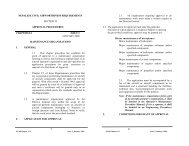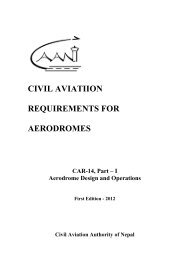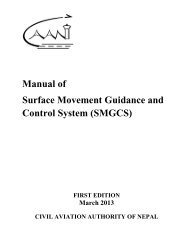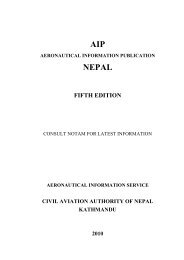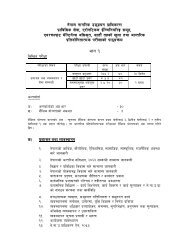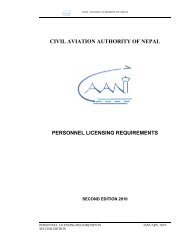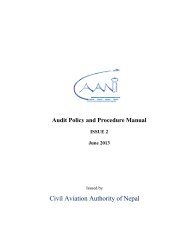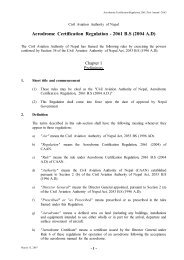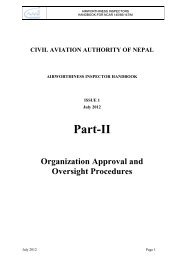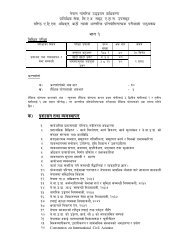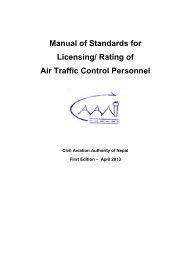CAAN Souvenir 2010.FH10 - Civil Aviation Authority of Nepal
CAAN Souvenir 2010.FH10 - Civil Aviation Authority of Nepal
CAAN Souvenir 2010.FH10 - Civil Aviation Authority of Nepal
- No tags were found...
Create successful ePaper yourself
Turn your PDF publications into a flip-book with our unique Google optimized e-Paper software.
<strong>CAAN</strong> <strong>Souvenir</strong> 2010to do this. Therefore, there is a need for guidance materialto be developed by ICAO and training to inspectors for theassessment <strong>of</strong> GPS IFR aircraft installations to enable a nominalPBN capability to be determined in the first instance withoutthe cost and overhead <strong>of</strong> having the complete GPS IFRinstallation recertified for PBN. Then GPS IFR approved aircraftneed to be integrated into PBN environment without causingundue cost to operators.Another issue for GNSS operation is human factors. RNAVoperations by GNSS has significant safety issues regardingthe human factors <strong>of</strong> RNAV systems designs, RNAV systemsinstallations in aircraft, and flight crew conducting RNAVoperations.The Cranfield University report has identified a number <strong>of</strong>human factors issues that need to be considered for theconduct <strong>of</strong> safe RNAV operations. There is a high error ratesfor crews carrying out missed approach on RNAV operations.These shortcomings stem from lack <strong>of</strong> understanding <strong>of</strong> systemsand their operating modes, training effectiveness and learningstyles, and other human factors in the cockpit. Oversight <strong>of</strong>operators RNAV operations needs to rest with a single entityto ensure that there is an overall approach to RNAV approvalsrather than the compartmentalized practice.Aircraft installation deficiencies have significant adverseimpact on crew performance. The report shows that it is notfeasible to carry out RNAV operations using conventionalaids. So dual RNAV systems fully integrated into the flightinstruments and autopilot is required to carry out the RNAVoperations. Charting issues were identified as being a majorsource <strong>of</strong> significant human factors concerns for crews. TheCranfield report concludes that charts need to be pilot orientedand to provide information in a manner that is directly usableby the crew and enhances situational awareness Therefore,operators emphasize all pilots involved in RNAV operationsto apply these Human Factor issues,PBN Implementation status in <strong>Nepal</strong><strong>Civil</strong> <strong>Aviation</strong> <strong>Authority</strong> <strong>of</strong> <strong>Nepal</strong> (<strong>CAAN</strong>) has formed aNational PBN Task Force headed by Deputy Director General<strong>of</strong> <strong>CAAN</strong> and members from various disciplines includingairlines pilots and PBN Focal Point has been designated tocoordinate and follow up the PBN Implementation.GNSS based approach and departure procedure has beendesigned for nine (9) airports including Tribhuvan InternationalAirport and some <strong>of</strong> them validated. A few GNSS Approacheswill be implemented in this fiscal year under PBN specification.The <strong>CAAN</strong> has initiated review <strong>of</strong> some GNSS/RNAVapproach and departure procedures in line with PBN conceptwith LNAV criteria for some airports and developingRNAV/RNP SIDs and STARs.<strong>CAAN</strong> has recently sent two (2) persons for basic PAN/OPSand two (2) persons for PBN Procedure Design Courseorganized in Beijing, China under ICAO/FPP Programme.Draft PBN implementation plan with implementation timeframe 2010-2012(Near Term) has been produced. DetailPBN Implementation Plan is under preparation by NationalPBN Task Force. Required Navigation Performance –Authorization Required (RNP-AR) procedure for TIA is underdevelopment with the assistance <strong>of</strong> QUOVADIS, a sisterorganization <strong>of</strong> Airbus Company.ConclusionLack <strong>of</strong> adoption <strong>of</strong> GNSS due to Regulation and OperationalApproval, Aircraft Certification, Pilot and Controller Trainingetc has hindered the progress <strong>of</strong> PBN implementation.Operators capability in terms <strong>of</strong> aircraft avionics, pilotscapability and human factor issues are other factors that areto be considered. The best <strong>CAAN</strong> do now is that nationalPBN Task force should gear up by taking in all the stakeholders and come up with the solid foundation for the nextgeneration navigation: the PBN.*Deputy Director, <strong>CAAN</strong>3512 th Anniversary Publication



